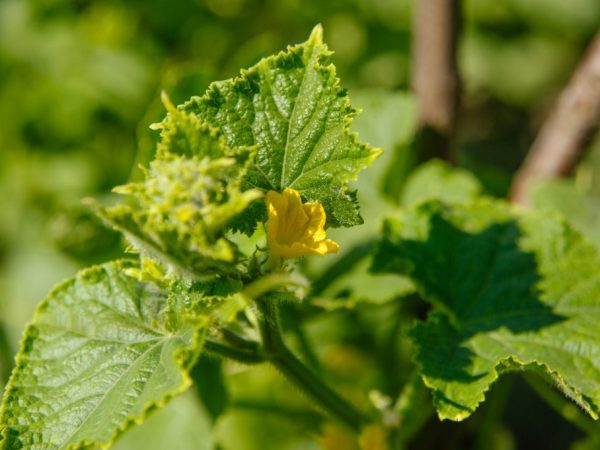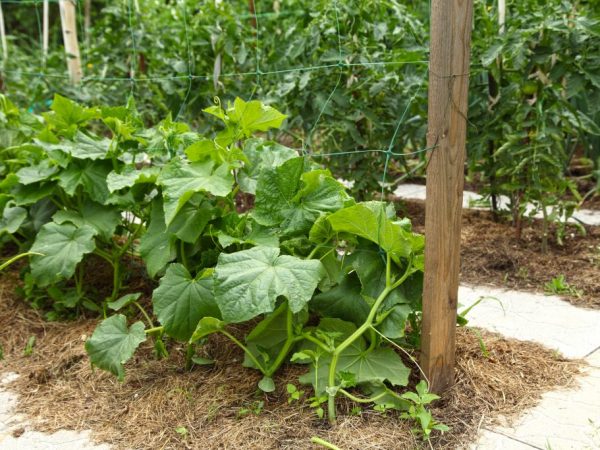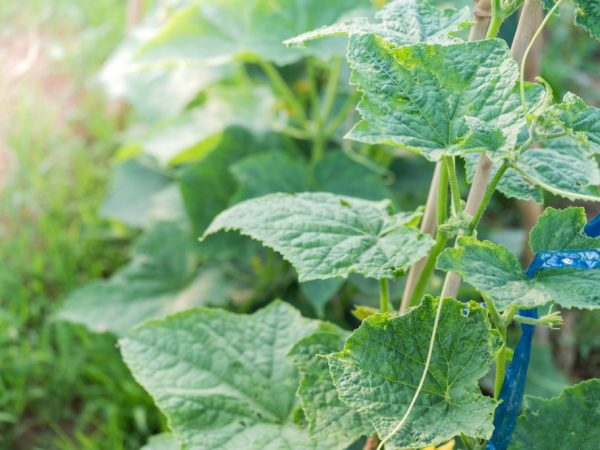Bush cucumbers for open ground
Gardeners have long been accustomed to a vegetable liana on their own plots, so it is difficult to surprise them with any new hybrid. Many farmers are not even aware of the existence of other forms of their favorite culture. What are outdoor bush cucumbers? Let's analyze the features of growing and list the varieties of an unusual plant.

Bush cucumbers for open ground
Characteristics of bush cucumbers
Even the most unpretentious vegetables need regular shaping and tying of the stem. To facilitate care, geneticists have developed interesting varieties that gardeners call "cucumbers for the lazy." What is their feature?
Appearance
Classic varieties have branching lashes more than 3 m long. They spread along the ground, which complicates harvesting and causes disease. Hybrids with a short stem (up to 80 cm) have several side shoots and look like ordinary bush plants. New cucumbers have small internodes, which gives the impression of a huge amount of foliage.
The compact crop is not a hassle to maintain. The processing of the beds is minimal and not difficult, and the lashes do not need to be tied up. Pollination occurs when any moisture (dew, irrigation) hits the pistil and stamen and does not require the presence of bees. Grown both in greenhouses and in the open field.
Fruit
With proper care, varieties of bush cucumbers surprise with their yield. Observing the minimum requirements, from 1 sq. m it is possible to collect up to 20 kg of tasty greens. Thanks to the unique genetics of the plant, ripening occurs amicably.
The fruits begin to ripen long before the main cucumber diseases appear in the garden.
The fruits of the hybrid have an easily recognizable shape: they are neat, small. Among the varieties, the most popular are universal, but there are also narrowly focused ones, intended exclusively for salads or canning. Cucumbers have a pleasant delicate aroma without specific bitterness.
How to plant
To get a rich harvest, you need to sow the seeds correctly. The first stage is one of the most important; plant immunity depends on it. Subject to simple rules, it is possible to fully reveal the potential of the variety.
Seedling method
To speed up fruit production when grown outdoors, it is best to use seedlings. The harvest of cucumbers ripens 2 weeks earlier than seeds planted directly in the ground. Bushes grow stronger and more adaptable to temperature fluctuations.
Before planting, the raw materials are soaked for 12 hours in a nutrient solution of fertilizer, water and wood ash. After the specified time, the seeds are washed with clean liquid and placed on a damp cloth for 2 days. The day before planting, the sprouted grains are sent to the refrigerator for tempering.

Seedling growing will speed up the fruiting process
For seedlings, cucumbers are sown in special boxes or separate pots. The culture is very demanding on the nutritional value of the land. A mixture of:
- peat;
- sawdust;
- humus;
- garden soil.
The components are thoroughly mixed, wood ash and a teaspoon of nitrophoska are added. Drainage is placed at the bottom of the pots, after which soil is poured. One grain is sown into each container, sprinkled with a small amount of water and covered with polyethylene. As soon as shoots appear, the film is removed. It is necessary to plant it in a permanent place of growth after 3 adult leaves have formed.
Seed method
If there is no time to deal with seedlings, it is advised to start growing bush cucumbers directly from the garden. Before agricultural work, the seeds are soaked in warm water for a day. The next day, the raw materials are laid out on a damp napkin for germination.
The place prepared for the garden is carefully dug up with organic or mineral fertilizers, and plant residues are removed. Unlike vegetable creepers, bush cucumbers need a denser sowing. On the day of planting, holes are dug according to the scheme:
- depth - 7;
- the gap between plants - 9;
- distance between rows - 45.
Excess soil over the grains stops growth. The pits are carefully sprinkled with loose earth, watered with warm water. If the spring is cold, cover the planting at night with a film.
Care
Self-pollinated bush cucumbers are not as capricious as their liana-like counterparts, but do not forget about the rules for growing a crop. This is important in the first weeks after planting outdoors. The agricultural technology of both types of plants is almost identical.
Watering
Due to the peculiarity of the structure, bush cucumbers need regular irrigation. After the sprouts have appeared and until the flowering stage, moisture is produced every day. During the period of fruit setting, procedures are reduced to 2 times a week.
The culture is very sensitive to temperature changes. Watering is carried out only with warm or settled water. To prevent the sun's rays from burning the delicate foliage, the procedure is carried out in the morning or in the evening.
Top dressing
Cucumbers are one of the most "voracious" plants, therefore, when grown in the open field, regular application of mineral or organic products is required. Nutrients not only activate the formation of greenery, but also improve the protective functions of the bushes. In one season, 5 stages of fertilization are carried out.
- Elementary. Needed 2 weeks after sprouting. Add 50 g of superphosphate to a bucket of water, 2 tsp each. urea and potassium sulfate, after which the beds are watered.
- Fastening. After 14 days after the first stage, additional fertilizing is carried out. For the procedure, you will need any mineral remedy for cucumbers.
- Before flowering. On the 10th day it is better to use the preparation "Effekton-O", which is diluted according to the instructions and watered under the root.
- For the formation of fruits. 8 days after the buds appear, it is advised to introduce the preparation Agricol Vegeta with the addition of a spoonful of nitrophoska.
- The last one. It is carried out on the 10th day after the penultimate procedure. You can take any complex mineral fertilizer for cucumbers.
Water the plants before feeding them. If you add nutrients to dry soil, the chemical solution burns the delicate roots of the culture. After such care errors, cucumbers get sick for a long time and leave, slowing down fruiting.
Self-pollinated varieties

Several varieties of cucumbers can be planted nearby
More than one hundred hybrids appear annually, but not all of them meet the requirements of domestic farmers. You don't have to buy expensive seeds to get a rich harvest. Farmers advise planting several varieties of bush cucumbers in one garden bed.
Sturdy baby
One of the most popular varieties on the domestic market.Compact self-pollinated plants grow well both in open ground and in a greenhouse, on a balcony. They are characterized by increased resistance to powdery mildew and spring frosts.
Fruits of the hybrid are small, gherkin type - no more than 10 cm. Neat cucumbers are covered with dark skin with light stripes and tiny tubercles. The fragrant pulp is not bitter, therefore it is used for salads and canning.
Aladdin
A good variety of Polish selection, it begins to bear fruit in the third month after pecking the seeds. A compact bush (up to 60 cm) resistant to downy mildew and not picky about care, not afraid of frost. Several zelents are tied in each knot. Productivity from 1 sq. m - not less than 5 kg.
Small cylindrical gherkins do not grow more than 8 cm in length. The cucumbers are covered with a thin green skin with small tubercles and light stripes. Thanks to their excellent aroma, vegetables are used fresh and canned.
Bee-pollinated varieties
Plant varieties that require insects are always more productive than their self-pollinated counterparts. Bush cucumbers grow well in open field conditions and do not require intensive care. Popular hybrids will allow you to find the optimal solution for yourself.
Kid
An early bee-pollinated variety for open ground gives the first harvest 40 days after seed germination. A small plant (up to 50 cm) resistant to cucumber mosaic virus and powdery mildew. It is not afraid of temperature changes, so it is allowed to plant it on a garden bed with seeds.
Up to 47 zelents can be removed from each bush of the Malysh F1 variety in one season. Gherkins do not grow more than 9 cm. The lumpy rind of a rich color covers the tasty pulp without specific bitterness. It belongs to the universal type of vegetables, therefore it is used both fresh and canned.
Bush
Another interesting hybrid that develops well in domestic conditions. The plant is a small bush (up to 70 cm) with short side branches. The bee-pollinated variety has a strong immunity to all cucumber diseases.
Gherkin-type fruits have an elongated shape, slightly resembling an egg. The delicate dark green rind is abundantly covered with tubercles. The peculiarity of the variety is the unusual flesh of a salty-bitter taste. Cucumbers are used for both salads and preservation.
Shorty
The bee-pollinated species of bush cucumbers is intended for cultivation in the open field. In a greenhouse, the yield is reduced by 1/3, so gardeners are not advised to experiment. The variety is resistant to all cultural ailments.
A small bush forms several zelents in each node. The fruits of the gherkin type hybrid are up to 10 cm in length. A thin, delicate skin covers the crispy, tart pulp, completely devoid of specific bitterness. They are used both for salads and for preservation.
Hector
An early ripening plant is distinguished by an amicable ripening of the crop. Compact and stocky, it begins to bear fruit 30 days after the seeds are hatched. Several cucumbers are formed in each nodule. The variety is resistant to all common diseases and is not afraid of temperature extremes.
Cylindrical greens grow on average up to 12 cm, which is typical for varieties of the gherkin type. The weight of one specimen reaches 95-100 g. The juicy crunchy pulp is endowed with a strong aroma without bitterness. Used fresh and canned.
Microsha
The bush-shaped bee-pollinated hybrid is suitable for both open ground and greenhouses. From the germination period to the first harvest of fruits, it takes about 6.5 weeks. It is resistant to all cultural diseases and does not die at slight temperature changes.
Gherkins grow up to 12 cm, weighing 110 g. The elongated shape is a bit like an egg.The dark lumpy skin covers the fragrant pulp, does not taste bitter and does not turn yellow, therefore it is suitable for salads and canned food.
Summarizing
Outdoor bush cucumbers are a great option for busy gardeners. With minimal maintenance and costs, you can get a bountiful harvest. The guidelines above provide an overview of growing and a complete overview of popular varieties.


